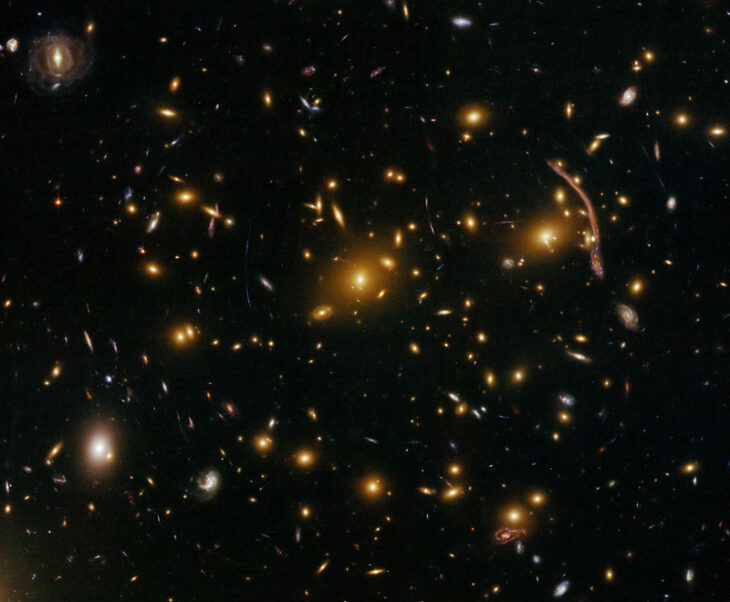A diverse array of objects exists in space, ranging in size from tiny dust particles to supermassive black holes. However, much of what astronomers study is groupings of these objects bound together by gravity. At the small end of these groupings are planets and their moons, referred to as systems. Then there are stars and their planets, known as planetary systems. Finally, there are stars, black holes, and the gas and dust between them, which are galaxies. Beyond that, groupings of objects so huge that they form larger patterns in the whole universe are called structures. A type of structure composed of hundreds to thousands of galaxies is known as a galaxy cluster.
Astronomers want to know how being part of a larger structure, like a galaxy cluster, affects all the objects in it, especially as the structure takes shape over time. One team studied what happened to galaxies as they fell into the Abell 496 cluster. The cluster’s mass is about 400 trillion times that of the Sun, and it is relatively nearby for a galaxy cluster at 140 megaparsecs, 4 sextillion kilometers, or 3 sextillion miles from the Earth.
They wanted to know how the galaxies evolved after they fell into the cluster. So they observed 22 galaxies inside Abell 496 to see if they could find any differences in how they formed stars as they fell farther into it. In particular, they aimed to pinpoint the moment in time over the last billion years when regular star-forming galaxies in this cluster ceased to create new stars.
The team combined 2 distinct pieces of data about the light coming from the galaxies they observed in the cluster. The first was long-wavelength emissions coming from neutral hydrogen atoms in the dust between the galaxy’s stars, known as HI and pronounced “H one.” They interpreted patterns in these HI emissions to find how much a galaxy has been disturbed by its proximity to other galaxies, and how much gas it has left to form stars. The team observed the HI emissions from these galaxies using the National Radio Astronomy Observatory’s Very Large Array.
The second piece of data they used consisted of short-wavelength far-ultraviolet emissions emanating from newly formed stars with masses between 2 and 5 times that of the Sun. These stars are short-lived with lifespans shorter than 1 billion years. Researchers use the emission patterns in these far-ultraviolet measurements to calculate the frequency at which stars form in galaxies. The team made these observations with the Ultra-Violet Imaging Telescope on the AstroSat satellite.
The team combined these data to unravel the history of each galaxy, including when their stars formed, when they started being affected by other galaxies, and how long their reserves of star-making gas lasted. Then, they used each galaxy’s position in the cluster and its trajectory to determine how the process of falling into the cluster had altered its evolutionary path.
They found that galaxies near the edge of the cluster formed stars at a rate they would consider undisturbed or main-sequence. They also found that over half of the 22 galaxies they studied were located at the center of the cluster, firmly bound together by gravity and subject to its secondary effects. However, of those galaxies, none had reached the part of their orbits where they pass closest to the exact center of the cluster, since they had only been falling into the cluster for the last few 100 million years.
The researchers used their data to develop a 5-step evolutionary sequence for galaxies that fall into a cluster. First, the galaxies begin to fall into a cluster and undergo default, main-sequence star formation, referred to as pre-triggering. Second, other galaxies in the cluster disrupt the falling galaxies’ HI, sharply increasing how frequently they form stars, referred to as initial star formation triggering.
Third, the galaxies’ HI is highly disturbed, and they form stars at their highest level, referred to as the peak of star formation. Fourth, their HI remains very disrupted, but far-ultraviolet emissions from star formation drop, referred to as their star formation fading. They estimated that these first 4 steps together would take a few 100 million years. Fifth, the galaxies’ HI is depleted, and star formation drops to levels below those of the pre-disturbance main sequence, referred to as quenching.
The team concluded that their method reconstructed a reasonable history of a galactic cluster. However, they suggested future teams should ensure that they have accurate methods for measuring both star formation and neutral gas in distant galaxies. They recommended that these teams use larger numbers of galaxies in clusters for more accurate statistical analyses and study multiple clusters with different local environments to better understand how galaxies evolve within larger structures.


